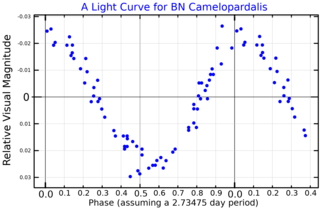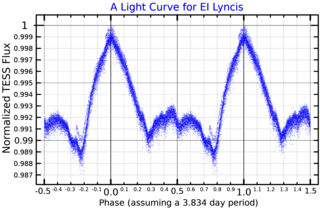
8 Andromedae, abbreviated 8 And, is a probable triple star system in the northern constellation of Andromeda. 8 Andromedae is the Flamsteed designation. It is visible to the naked eye with an apparent visual magnitude of 4.82. Based upon an annual parallax shift of 5.7 mas, it is located about 570 light years from the Earth. It is moving closer with a heliocentric radial velocity of −8 km/s.

2 Andromedae, abbreviated 2 And, is a binary star system in the northern constellation of Andromeda. 2 Andromedae is the Flamsteed designation. It is a faint star system but visible to the naked eye with a combined apparent visual magnitude of 5.09. Based upon an annual parallax shift of 7.7 mas, it is located 420 light years away. The binary nature of the star was discovered by American astronomer Sherburne Wesley Burnham at Lick Observatory in 1889. The pair orbit each other over a period of 74 years with a high eccentricity of 0.8.

56 Arietis is a single, variable star in the northern zodiac constellation of Aries. It has the variable star designation SX Arietis, while 56 Arietis is the Flamsteed designation. This object is visible to the naked eye as a faint, blue-white hued point of light with a baseline apparent visual magnitude of 5.79. The estimated distance to this star is approximately 415 light-years, based on parallax, and it is drifting further away with a radial velocity of +18 km/s.

36 Aurigae is a single variable star located about 910 light years away from the Sun in the constellation Auriga. It has the variable star designation V444 Aurigae, while 36 Aurigae is the Flamsteed designation. This object is visible to the naked eye as a dim, white-hued star with a baseline apparent visual magnitude of 5.71. It is moving further from the Earth with a heliocentric radial velocity of +16 km/s.
53 Aurigae is a binary star system in the northern constellation of Auriga. It is visible to the naked eye as a dim star with a combined apparent visual magnitude of 5.74. Parallax estimates put it at a distance of 383 light-years away. The system is receding from the Earth with a heliocentric radial velocity of 13 km/s.

Lambda Capricorni, Latinized from λ Capricorni, is a solitary star in the southern constellation of Capricornus. It is faintly visible to the naked eye with an apparent visual magnitude of +5.56. Based upon an annual parallax shift of 11.58 mas as seen from the Earth, the star is located about 282 light years from the Sun. At that distance, the visual magnitude is diminished by an extinction factor of 0.11 due to interstellar dust.

HD 125823, also known as V761 Centauri or a Centauri, is a variable star in the constellation Centaurus. It is a blue-white star that is visible to the naked eye with a mean apparent visual magnitude of +4.41. The distance to this star is approximately 460 light years based on parallax measurements. It is a member of the Upper Centaurus–Lupus subgroup of the Scorpius–Centaurus association.

Epsilon Cephei, Latinized from ε Cephei, is a star in the northern constellation of Cepheus. Based upon an annual parallax shift of 38.17 mas as seen from the Earth, it is located about 85 light years from the Sun. The star is visible to the naked eye with an apparent visual magnitude of 4.18.

KK Andromedae, also known as HD 9531, is a variable star in the northern constellation of Andromeda. It has an apparent visual magnitude of 5.90, which places it near the lower limit of visibility to the naked eye even under good viewing conditions. An Alpha2 Canum Venaticorum variable, it varies in brightness by 0.012 magnitude every 0.66 days. Based upon an annual parallax shift of 7.5 mas as seen from Earth, it is located around 437 light years from the Sun. At that distance, the brightness of the star is diminished by an extinction of 0.26 magnitude due to interstellar dust.

ET Andromedae is a binary star system star in the northern constellation of Andromeda. It has an apparent visual magnitude of 6.48, placing it at the nominal limit for visibility with the naked eye. The distance to this system can be estimated from its annual parallax shift of 5.42 mas, which yields a value of 602 light years.

16 Lyncis is a star in the constellation Lynx. It is positioned next to the western constellation border with Auriga, and is also known as Psi10 Aurigae, which is Latinized from ψ10 Auriga. The star has a white hue and is visible to the naked eye with an apparent visual magnitude of 4.90. The distance to this object is approximately 241 light-years based on parallax, but it is drifting closer to the Sun with a radial velocity of −12 km/s. It has an absolute magnitude of 0.56.

IQ Aurigae is a single, variable star in the northern constellation of Auriga. It is visible to the naked eye as a dim, white-hued star with an apparent visual magnitude that fluctuates around 5.38. The star is located at a distance of about 460 light-years from the Sun based on parallax and is drifting further away with a radial velocity of +28.6 km/s.

V352 Aurigae is a variable star in the northern constellation of Auriga. It dimly visible to the naked eye with an apparent visual magnitude that ranges from 6.13 down to 6.18. According to the Bortle scale, it is faintly visible to the naked eye from dark rural skies. The star is located at a distance of approximately 970 light years from the Sun based on parallax, but is drifting closer with a radial velocity of −7 km/s.

BX Boötis is a star in the northern constellation of Boötes. It is a dim star near the lower limit of visibility to the naked eye, having a nominal apparent visual magnitude of 6.35. Based upon an annual parallax shift of 10.81 mas, it is located 302 light years away. At that distance, the visual magnitude of the star is diminished by an extinction of 0.13 due to interstellar dust. It is moving closer with a heliocentric radial velocity of −11 km/s.

BN Camelopardalis is a suspected astrometric binary in the northern circumpolar constellation of Camelopardalis. It appears as a variable star that is visible to the naked eye as a dim, white-hued point of light with an apparent visual magnitude that fluctuates around 5.49. The system is located at a distance of around 310 light years from the Sun based on parallax, and is drifting further away with a radial velocity of +9 km/s.

36 Lyncis is a solitary variable star located around 620 light years away from the Sun in the northern constellation of Lynx. It has the variable star designation of EI Lyncis, while 36 Lyncis is the Flamsteed designation. This object is visible to the naked eye as a dim, blue-white hued star with an apparent visual magnitude of 5.30. It is moving further away from the Earth with a heliocentric radial velocity of 21 km/s.

GR Andromedae is a variable star in the constellation Andromeda. Its apparent visual magnitude varies between 6.87 and 6.95 in a cycle of 518.2 days. It is classified as an α2 Canum Venaticorum variable.

HN Andromedae is a variable star in the constellation Andromeda. Its apparent visual magnitude varies between 6.67 and 6.76 in a cycle of 69.51 days. It is classified as an α2 Canum Venaticorum variable.

HD 125248 is a binary star system in the equatorial constellation of Virgo. It has the variable star designation CS Virginis, while HD 125248 is the designation from the Henry Draper Catalogue. This system is dimly visible to the naked eye as a point of light with an apparent visual magnitude that ranges from 5.84 down to 5.95. It is located at a distance of approximately 280 light years from the Sun based on parallax measurements, but is drifting closer with a heliocentric radial velocity of −8 km/s.

PW Telescopii, also known as HD 183806 or simply PW Tel, is a solitary variable star located in the southern constellation Telescopium. It has an average apparent magnitude of 5.58, making it faintly visible to the naked eye. Based on parallax measurements from the Gaia satellite, the star is estimated to be 395 light years distant. It appears to be approaching the Solar System with a heliocentric radial velocity of −10 km/s. The value is somewhat constrained, having an uncertainty of 26%. At its current distance, PW Tel's brightness is diminished by 0.05 magnitudes due to interstellar dust.



















